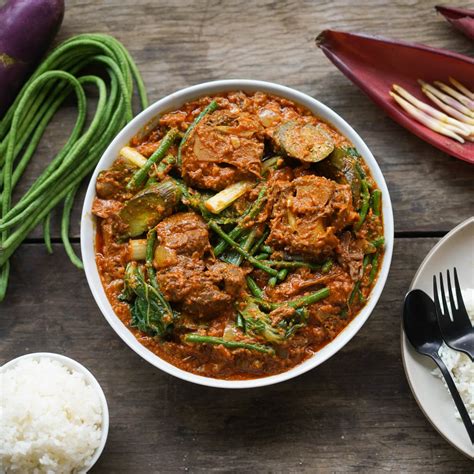Kare-Kare: A Delicious Dive into Filipino Cuisine
Kare-Kare, a rich and savory Filipino stew, is a culinary masterpiece that tantalizes taste buds with its complex blend of flavors and textures. This iconic dish, a staple at Filipino celebrations and family gatherings, is a true testament to the country's vibrant culinary heritage. Let's explore this beloved recipe and uncover the secrets to making a truly authentic Kare-Kare.
Understanding the Heart of Kare-Kare: Peanut Sauce
The soul of Kare-Kare lies in its creamy, intensely flavorful peanut sauce. This isn't your average peanut butter; it's a meticulously crafted blend of roasted peanuts, meticulously ground to achieve the perfect consistency. The depth of flavor is often enhanced by the addition of annatto seeds (achuete), which impart a vibrant reddish-orange hue and a subtle earthy note. The key to a truly exceptional Kare-Kare is the quality of the peanut sauce. Don't rush this process! Take your time to properly roast the peanuts and grind them for a smoother, richer sauce.
Essential Ingredients for the Peanut Sauce:
- Roasted Peanuts: The foundation of your sauce. Look for high-quality peanuts for the best flavor.
- Annato Seeds (Achuete): For color and a subtle earthy flavor.
- Ginger and Garlic: For aromatic depth.
- Shrimp Paste (Bagoong): This adds a salty, umami punch – use sparingly at first, as the flavor is potent.
- Vinegar: A touch of acidity balances the richness of the sauce.
- Water: To adjust the consistency.
Beyond the Sauce: Building the Kare-Kare's Flavor Profile
While the peanut sauce is the star, the ingredients that accompany it are equally crucial to the Kare-Kare experience. The stew typically features a variety of meats and vegetables, creating a symphony of textures and tastes.
Common Kare-Kare Ingredients:
- Oxtail: A traditional choice that provides a rich, gelatinous broth. However, you can substitute with beef shanks or even pork ribs for a more accessible option.
- String Beans (Sitaw): Adds a crisp, slightly sweet counterpoint to the richness of the sauce.
- Eggplant: Absorbs the flavorful sauce beautifully.
- Green Papaya: Offers a subtle sweetness and pleasant crunch.
- Spinach or Kangkong (Water Spinach): Added towards the end for a vibrant green color and fresh flavor.
Preparing the Kare-Kare: A Step-by-Step Guide
While precise measurements can vary depending on personal preference, here's a general outline of the process:
- Prepare the Meat: Boil the oxtail (or your chosen meat) until tender. This will form the base of your stew.
- Make the Peanut Sauce: Roast the peanuts, blend them with the other sauce ingredients until smooth and creamy. Adjust seasonings to your liking.
- Combine and Simmer: Add the cooked meat and vegetables to the peanut sauce. Simmer until the vegetables are tender but still retain a bit of their crispness.
- Garnish and Serve: Traditionally served with bagoong (shrimp paste) and a side of rice. The contrast of flavors and textures is what makes this dish so unforgettable.
Optimizing Your Kare-Kare Experience: Tips and Tricks
- Don't be afraid to experiment: While tradition is important, feel free to adjust ingredients to suit your preferences.
- Toast your peanuts: Roasting the peanuts intensifies their flavor and adds depth to the sauce.
- Adjust the consistency: Add more water if the sauce is too thick, or simmer longer if it's too thin.
- Use fresh ingredients: Fresh, high-quality ingredients will significantly elevate the taste of your Kare-Kare.
Kare-Kare is more than just a recipe; it's a culinary journey into the heart of Filipino culture. By following these steps and embracing the nuances of this flavorful stew, you'll be well on your way to creating a truly authentic and unforgettable Kare-Kare experience. Enjoy!
